And in your creation and all the creatures He has spread about there are Signs for people with certainty.
(Surat al-Jathiyya, 4)
The Extraordinary Variety Of Life
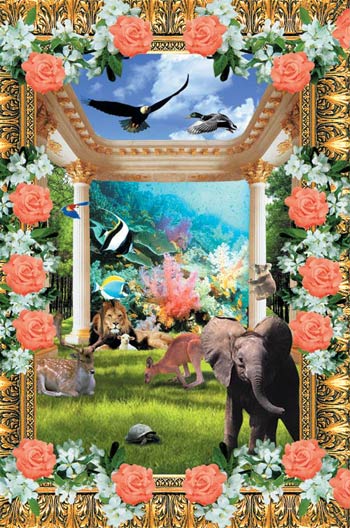
Life can be found just about everywhere on Earth, whether it's visible or not. Almost no place is without life forms of some kind. A vast number of species live in all habitats, in close harmony with both those environments and with one another. From a drop of sea water to the boundless oceans, from a handful of soil to whole continents, from ice caps to thermal springs, from many meters below the ground to the air you breathe, from deep within our bodies to your own skin...
In addition, the Earth plays host to living things with very different body structures, internal systems, forms of behavior and characteristics: From a bacterium just 1 millionth of a meter in size to a giant sequoia tree some 100 meters (328 feet) high and 2,500 tons (5,512,000 pounds) in weight; from deep-rooted trees to terns that fly 20,000 kilometers (12,430 miles) on their migrations or salmon that swim for thousands; from a mayfly with a life span of just a few hours to the creosote bush that can live for more than 1,000 years; from the grouper fish that travel singly through the oceans to ants that live in colonies of several millions; from a delicate orchid to insects that are impervious even to radiation...
As Dr. G. David Tilman, Professor of Ecology from University of Minnesota puts it, "The most striking feature of Earth is the existence of life, and the most striking feature of life is its diversity."2
To describe the variety and richness of life on our plant, scientists use a special term: Biodiversity. This term was adopted from biological diversity and includes animals, plants, fungi and micro-organisms—in short, all living things.
The term biodiversity is now widely employed, but contrary to what is often imagined, it has only recently become a familiar term. No matter how far back in history one researches the variety of life, the special term of biodiversity entered scientific circles only in 1986. That year, the concept was born at the Biodiversity Symposium held by the American National Academy of Sciences and the Smithsonian Institution.3
Following that, there was a rapid increase in initiatives drawing attention to the importance of biological diversity and the need to protect it. Following the United Nations Conference on the Environment and Regeneration, held in Rio de Janeiro in June 1992, biodiversity became one of the subjects of joint concern for all the countries of the world.
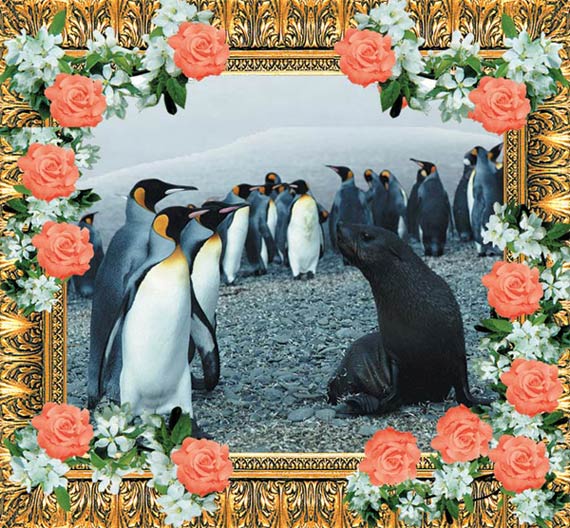
How Many Species Are There on Earth?

In biology, the concept of species is used to describe, understand and reduce biodiversity to a specific number. A living species consists of a population whose members can reproduce only among themselves and that share similar structural and functional characteristics. (This concept will be explored further in Chapter 3, "Evolution's Speciation Dilemma.")
How many species are there on Earth? That question has long intrigued a great many people. Wide-ranging research is now being carried out to answer it. To date, scientific studies have revealed that no definite figure can be given, only that it is exceedingly large.
The eminent zoologist Edward O. Wilson, one of the scientists who first came up with the concept of biodiversity, is regarded as an authority in the field.4 A professor at Harvard University, he offers the following analysis:
No one knows the number of species of living organisms, but there are probably at least 5 million, and the number could be as high as 100 million. Consider first the question of the amount of biodiversity. The number of species of organisms on Earth is unknown to the nearest order of magnitude. About 1.5 million species have been given names to date, but the actual number is likely to lie somewhere between 10 and 100 million.5
Thomas E. Lovejoy is President of the H. John Heinz III Center for Science, Economics and the Environment and an expert on biodiversity:
While the number of species currently described is on the order of 1.4 million, the big question is how many species are there totally? Current estimates of the total number of species run from 10-100 million.6
In a paper, Professor Quentin Wheeler of Natural History Museum, London and Professor Joel Cracraft of the American Museum of Natural History submitted their own estimate of biodiversity:
Despite having accumulated significant knowledge about the world's species over the past 2 centuries, we still cannot provide accurate answers to the simplest of all questions about biodiversity. How many species are there? Estimates vary from 3 to 100 million species.7

Taylor Ricketts of Stanford University says that: "The Earth is home to over 1.7 million known species, and probably 10 times that number have yet to be discovered."8
Alessandro Minelli from the University of Padua states that "Global estimates of existing biodiversity are thus quite uncertain. Figures ranging from 5 to 130 million species have been recently offered for the gross total."9
According to The Encarta Encyclopedia, the identified and named species number 1.75 million, and some scientists estimate the total number of species on Earth to be around 10 millionand others, more than 100 million.10 According to the Encyclopedia Britannica, many more species are waiting to be identified and named, and there are currently estimated to be between 10 and 30 million living species.11
Also, these estimates are for species currently living and do not include those that have become extinct.



The Scale of Biodiversity

Enough information that controls the body's functions has been coded in the cell nucleus of every human being to fill a 1-million-page encyclopedia. Bearing in mind that man is just one species among tens of millions, a truly extraordinary picture emerges.
To provide an idea of the impressive richness of micro-organism, fungi, plant and animal species on Earth, a few examples can be cited. According to Professor Wilson's calculation, a catalogue describing merely a million species would fill a 60-meter library shelf.12
To view biodiversity from another angle, let us now include species' genetic richness in the calculation. The information controlling the body's functions, encoded in the human DNA molecule in the nucleus of every cell, would fill an encyclopedia containing a million pages. Bear in mind that Man is only one of 10 million species, and a truly extraordinary picture emerges: Were we to write down all the genetic information for all those species, there would not be enough paper in the world to do so.
The number of single-celled eukaryotes (Protista), algae, bacteria, fungi, seaweeds, flowering plants, sponges, corals, insects, birds, reptiles, fish and mammals—in short, the number of the categories of all living things—is so huge that some scientists and researchers think that the target of determining and describing all species is unattainable.13
Two researchers from London's Imperial College, Andy Purvis and Andy Hector, published an article in Nature magazine titled "Getting the Measure of Biodiversity." They emphasized the point that computer databases and internet technology have prepared far more comprehensive species lists than ever before; and that trillions of bytes of information have been collected together in data banks. However, all this information is no more than "a small drop in the ocean," as Purvis and Hector put it.14
But the really impressive thing is not just the total number and diversity of species. Within each species, there are also a large number of variations. For instance, all dogs belong to the single species of Canis familiaris. But in addition, there are hundreds of diverse breeds with different appearances, sizes, body structures, colors, and forms of behavior.

There are hundreds of breeds of dog, all with different appearances, weights, colors, forms of behavior and characteristics. Yet they are all still the same species.
Another phenomenon is that some animal species exhibit different body structures at different periods in their lives. During its pupa, larva and adult stages for example, a butterfly or moth exhibits an enormous variety in terms of structure, size, color, life style, behavior and biological systems.
Type Names | Number of Species Described | Estimated Number of Species |
|---|
Bacteria | 4.000 | 1.000.000 |
|---|---|---|
Fungi | 75.000 | 1.000.000 |
Eukaryotic single-celled organisms | 40.000 | 300.000 |
Algae seaweeds | 45.000 | 400.000 |
Land plants | 270.000 | 300.000 |
Round worms | 25.000 | 500.000 |
Crustaceans | 45.000 | 150.000 |
Arachnids | 80.000 | 750.000 |
Insects | 1.000.000 | 10.000.000 |
Mollusks | 100.000 | 200.000 |
Chordates | 50.000 | 55.000 |
Others | 130.000 | 300.000 |
Total (approximately) | 1.900.000 | 15.000.000 |
Table Of Biodiversity
Anyone realizing the wealth of biodiversity on Earth needs to ask an important question: How did such a variety of life emerge?
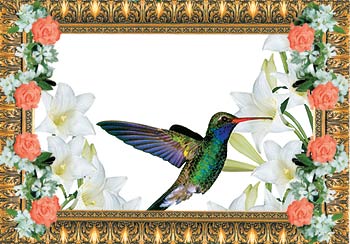
This question has always given evolutionists a major headache, and will always continue to do so. Writing a so-called evolutionary scenario for even a single species is a major problem for Darwinism, and the evolution of millions of species is an irresolvable one. People who set aside preconceptions on the other hand, clearly understand that all living species came into being by the wish and creation of God, Lord of the worlds. This is the sole explanation for the magnificent diversity of species, and looking for any other is a waste of time.
No matter how much large, attractive animals like birds, reptiles and mammals attract notice, insects are actually the group with the greatest diversity. According to contemporary findings, insects represent over two-thirds of the total number of species on Earth.15 Approximately 1 million species belonging to this group have been named and described so far.16
As research deepens, brand- new scientific discoveries are made, and new plants, animals, insects and marine life forms are discovered every year. Every new study sheds light on one unknown aspect of the world's wealth of variety. Therefore, the numbers and proportions in the above table will change over time.
The distribution of Earth's biodiversity is not fully known. One fact observed so far is a general increase in the number of species as one descends from the poles towards the equator. Nothing more definite can be said, mainly because countless ecosystems, on both land and in the sea, are still waiting to be studied. Many regions on Earth have still not been comprehensively examined.
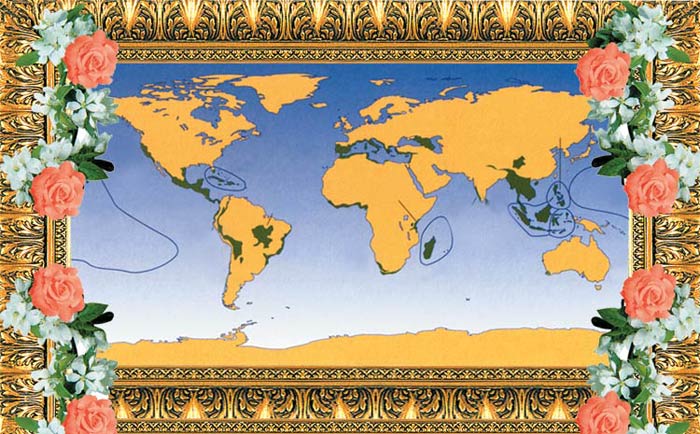
California Flower Fields
Polynesia Micronesia
Mesoamerica
West Ecuador
Central Chile
Brazil Atlantic forests
Brazil
The Caribbean
The Mediterranean Basin
Tanzania Eastern strip of Kenya
West African forests
Fertile Karoo
Cape Flower Fields
Madagascar
Wallacea
Sundaland
West Ghats and Sri Lanka
India Burma
The Caucasus
Central and southern China
Southwestern Australia
New Zealand
New Caledonia
Polynesia Micronesia
The Philippines
Terrestrial biodiversity is found in only 1.4% of the planet's land mass. Locales that are rich in such diversity are at the same time home to rapidly growing human societies.
Places particularly rich in terms of species are known as hot spots, and found generally in tropical regions and islands. The organization called Conservation International has stated that while land-dwelling life forms comprise only 1.4% of life on Earth, some 25 hot spots contain roughly half of all land-dwelling species.17
Researches in the World of Science

Carl Linnaeus
In the 250 years since the publication of Systema Naturae, a book by Carl Linnaeus, who is one of the most eminent names in the history of science, some 1.75 million species have been named and described—again, only a very small part of the world's total number of species. But these species named by researchers have not yet been collected under a single scientific index. As yet, there is no list containing all the known animals, plants, fungi and micro-organisms.18
This state of affairs can be compared to a library with nearly 2 million books, but no ordered index that lists them all.
The lack of a catalog including all species naturally gives rise to some confusion. In order to eliminate this, many scientists are trying to collect the names of all known species under a comprehensive index. For example, the Species 2000 program is one such study, intended to catalog all known species.19 By the end of 2001, this project, had listed some 250,000 species, and existing global species databases may presently account for some 40% of the total known species. 20
Other studies are being carried out to identify as yet unknown species. Thousands of scientists from many countries, particularly the USA, are now researching the species on Earth. The total budget set aside for this endeavor is hundreds of millions of dollars. Many institutions whose objective is to discover and understand diversity are active today.
Within the framework of this research, 2001 and 2002 were declared to be International Biodiversity Observation Years, and a special study to which eminent biologists, environmentalists and experts are participating was initiated in order to obtain more information about species throughout the world.21 This research is regarded as one of the most important developments in 21st century science. Diana Wall, a professor at Colorado State University and Director of the International Biodiversity Observation Year Management Board, summarizes the importance of this research:

Research into biodiversity will be of great benefit in many fields, from discovering new genetic compounds and chemical substances to be used in drugs to crop improvement and the cleanup of polluted regions.
Scientists have described about 1.75 million species, but we estimate that there are over 12 million species still to be described. For 99% of species we simply don't have good information on their distribution, abundance, whether they are plentiful or endangered, or their role in providing goods and services that we get from ecosystems, such as renewal of soil fertility, decomposition of waste and purification of water…
Exploring biodiversity will unlock many benefits, through discovery of new genes and chemicals that can be used for drugs, to improve crops, or to restore polluted land. Perhaps even more importantly, learning where species are, their role in maintaining healthy ecosystems, and how we can conserve them will be vital for making more informed decisions about our land, rivers and oceans.22
A new study initiated in this field is the All Species project.23 Eminent biodiversity experts such as Edward Wilson and Peter Raven are involved in this project, whose aim is to name and describe all species, and to prepare an Internet page for each one. This project is far more complex than other studies being carried out in the world of science, and a much wider-ranging one than the Human Genome project, as was made clear in the 26 October 2001 issue of Science magazine. According to All Species Project researchers' estimates, it will cost some $20 billion to establish a data bank of all species. 24 This cost alone is enough to give an idea of the project's size.
It therefore seems certain that increasing research will permit us to discover previously unknown species. Every organism newly discovered, from smallest to the largest, once again shows thinking and rational people the sublime nature of their own creation.

The Latest Situation
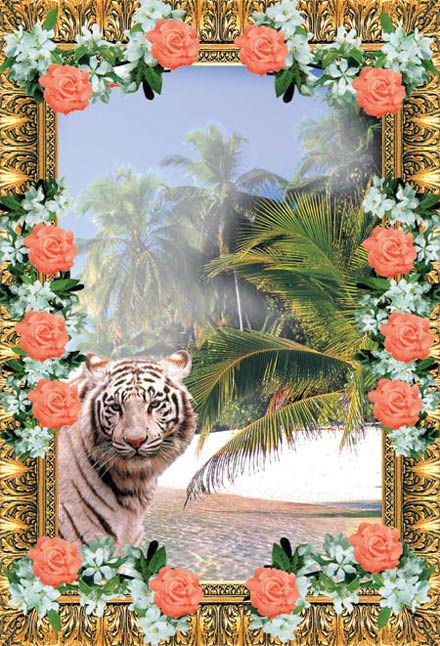
How much do we know about the variety of life on Earth as a result of high-budget and wide-ranging studies in the early 21st century?
Important answers to these questions will once again reveal that biodiversity is an incomparable marvel of creation.
Scientists all agree that we still have a long way to go. As Professor Wilson has put it, "only a tiny fraction of biodiversity on Earth has been explored."25 Professor Peter Raven, director of the Missouri Botanical Garden, emphasizes that, "the task is one of enormous importance."26
Remember, some 1.75 million known species have yet to be set out and classified according to scientific criteria. As stated by Professor Minelli, "There are serious problems, indeed, even with that part of biological diversity that has been already described and named."27 Another researcher, John Alroy of California University, says that in all likelihood, one-fifth of all species names in the scientific literature are invalid.28
According to World Resources Institute experts, we know more about the numbers of stars in space than those of the species on Earth.29 Norman Myers, an eminent Oxford university environmentalist, expresses this in another way:
While biodiversity, and indeed life itself, is the key characteristic of our planet, we know more about the total numbers of atoms in the universe than about Earth's complement of species.30
Another scientist to express this is Nigel E. Stork, Director of the James Cook University Tropical Rain Forest Ecology and Management Research Centre. Professor Stork says that the data regarding biodiversity are highly deficient:
In recent years biologists have come to recognize just how little we know about the organisms with which we share the planet Earth. In particular, attempts to determine how many species there are in total have been surprisingly fruitless... What these arguments show is how little we actually know about some of the fundamental aspects of the biology and distribution of organisms. We cannot say how widespread species are, we do not know the size of the species pool, and we do not know how specific species are to a particular habitat, type of soil, type of forest, or, in some cases, a species of tree. 31
To summarize, the distribution, densities, positions in their habitats and levels of genetic variety of most named species are not yet known for certain.32 Furthermore, the great majority of existing species have not yet been described. Despite all our efforts, we know only a very small part of the magnificent variety of life on Earth.
As you shall see in the chapters that follow, this magnificent richness of species definitively refutes the theory of evolution, which claims that living things came into being as the result of chance, and proves one single fact in a way that permits no doubt: Creation.
The glorious richness of life on Earth is the result of a very special creation that belongs only to God, the Almighty and Omniscient. His creation of all things is revealed in various verses:
With the creation of the heavens and the earth, they emit all the creatures of His Signs is ... (Surat ash-Shura, 29)
... There is no joint estate Him, He created everything and gave an order, has recognized a certain measure. (Surat al-Furqan, 2)
 He cast firmly embedded mountains on the earth so it would not move under you, and rivers and pathways so that hopefully you would be guided. |
Ecosystems and Biodiversity

Living things exist in complete harmony with each other and with their surroundings. With the disappearance of a single species, the whole ecosystem is disrupted and balance is damaged.
A specific area's ecosystem includes all the living things in it, as well as their physical surroundings. Lakes, forests, and coral reefs, together with the living things they harbor, are all examples of ecosystems. Lake Baikal in Siberia, for instance, is an ecosystem containing 1,500 plant and animal species.33
Each ecosystem has its own unique variety of life. For example, there are dozens of species of trees in a typical North American forest, and hundreds in a South American rain forest.
The point to be emphasized is that any balanced, healthy ecosystem hosts a wide spectrum of living species. A large number of species are linked to one another within a very complex interconnected system, and these play a greater or smaller part in the balanced functioning of the ecosystem as a whole—so much so that sometimes, the absence of a single species can impair an entire system and damage its equilibrium. For example, in the late 19th and early 20th centuries, otters in the Northwest American and Western Canadian coasts were hunted almost to the point of extinction. The otters fed on sea urchins, and when these mammals practically disappeared, sea urchins multiplied rapidly and began damaging seaweed beds. Damage to the seaweed had a harmful effect on several species of fish and invertebrates in those same waters and led to a decline in their numbers.
Toward the end of the 20th century, when otters were made a protected species, the seaweed began increasing, and balance in the region was re-established.34
Many more similar cases have been observed, helping us to understand that species spend their lives in perfect harmony with each other and with their surroundings.
But the term extraordinarily complex utterly fails to do justice to the complexity of the system constituted by the glorious variety of life on Earth. To obtain a closer understanding of this, consider the following: Even if all scientists work together, combining all our accumulated technological and scientific knowledge and material means, not even the smallest imitation of one of these systems can be produced. Professor Wilson says that it is totally impossible for scientists to collect species beforehand from a rain forest about to be cut down and to introduce them all somewhere else:

The biologists cannot accomplish this task, not if thousands of them came with a billion-dollar budget. They cannot even imagine how to do it. In the forest patch live legions of species: perhaps 300 birds, 500 butterflies, 200 ants, 50,000 beetles, 1,000 trees, 5,000 fungi, tens of thousands of bacteria and so on down a long roster of major groups. Each species occupies a precise niche, demanding a certain place, an exact microclimate, particular nutrients and temperature and humidity cycles with specified timing to trigger phases of the life cycle. Many, perhaps most, of the species are locked in symbioses with other species; they cannot survive and reproduce unless arrayed with their partners in the correct idiosyncratic configurations.
Even if the biologists pulled off the taxonomic equivalent of the Manhattan Project, sorting and preserving cultures of all the species, they could not then put the community back together again. It would be like unscrambling an egg with a pair of spoons. 35
From Professor Wilson's statements, you can see that no ecosystem can ever be established using human intelligence and knowledge. Therefore, it is totally impossible for ecosystems to come into being through blind chance, as evolutionists maintain. The following statement by the well-known Professor of Botany Karl Niklas from Cornell University is significant:
I don't think that the ecological patterns that we see surfacing in fossils and living organisms and across the continents are a consequence of chance.36
Ecosystems operating in perfect harmony are no doubt manifest proofs of the fact of Creation and the existence of a sublime Creator. At the same time, the Earth's biodiversity and flawless order completely refute Darwinism, which claims that they formed as the result of blind chance and random coincidences.
Let's have a closer look at the fact of Creation in certain ecosystems with a wealth of biodiversity.
Lessons to be Learned From the Biosphere 2 Project
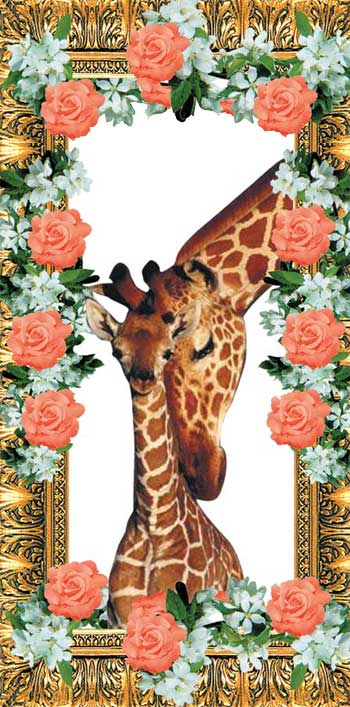
Our own lives depend indisputably on millions of other living species, flawless balances and perfectly functioning ecosystems. The purification of the water you drink, the production of the air you breathe and the food you eat, the fertilization of agricultural land, the production of raw materials in the objects you use and countless other activities are all carried out by living things. Most people fail to properly appreciate these blessings they obtain from living things that live side by side with them, and most do'nt even feel the need to think about them. Yet to free one from lazy thinking and familiarity, what would happen if the living things that perform these services for us ceased to exist?
Clearly, we, too, would be unable to survive. Even if we mobilized advanced technology and our entire material means, we could never establish the balances and conditions essential to our survival. The latest scientific research to confirm this fact was the Biosphere 2 Project, regarded as the largest and most complex closed study area used in ecological research to date.
This project aimed to establish an ecosystem that would provide a habitat for eight people, plants and animals for a two-year period in a closed area of 13,000 square meters (15,550 square yards) in size.37 The system contained "rooms" resembling such natural ecosystems as agricultural areas, forests and seas. However, the project was a failure, which disappointed a great many scientists. Joel Cohen of Rockefeller University and David Tilman of Minnesota University described the result of this initiative in an article in Science magazine:
Despite the enormous resources invested in the original design and construction (estimated at roughly $200 million from 1984 to 1991), and despite a multimillion-dollar operating budget, it proved impossible to create a materially closed system that could support eight human beings with adequate food, water, and air for 2 years. The management of Biosphere 2 encountered numerous unexpected problems and surprises, even though almost unlimited energy and technology were available to support Biosphere 2 from the outside. 38
Some of the unexpected problems that emerged in the facility between 1991 and 1993 and made life impossible included a drop in oxygen levels to 14%, sudden rises in the carbon dioxide concentration, a rise in the amount of nitric oxide sufficient to cause brain damage, the disappearance of most of the living species (including 19 of 25 vertebrate species and all pollinators brought into the enclosure, which would have ensured the eventual extinction of most of the plant species as well), water pollution, excessive algae, and population explosion of crazy ants, cockroaches and katydids.39
In short, despite all the efforts made, it proved impossible to produce in the closed Biosphere 2 system the balances that have been operating for millions of years on Earth, and thus it was impossible to establish an environment habitable for humans, animals and plants.

Despite Biosphere 2's unique design and the impressive resources employed in its construction, it was impossible for its closed system to recreate the balances that have been operating flawlessly on Earth for millions of years. Therefore, it was not possible to produce a self-sustaining environment habitable by human beings, plants and animals..
In conclusion, Professor Cohen and Professor Tilman summarized the lesson to be learned from the project:
No one yet knows how to engineer systems that provide humans with the life supporting services that natural ecosystems produce for free.40
The Rain Forests

Whenever tropical rain forests are mentioned, the first things that come to mind are dazzling butterflies, unusual-looking insects, and large, broad-leaved, trees. Rain forests are found in regions close to the equator and consist of dense trees that are always green and very tall. These forests' most important feature is the extraordinary number of plant and animal species they contain. A tropical rain forest, millions of square kilometers in size, is home to a wide variety of species.
Around 250 years ago, the first European researchers to set foot in the rain forests of South America were astonished by the variety of life they encountered. Each new study again revealed the diversity of plant and animal species.
A rain forest in the tropical belt has very different characteristics from those of other forests. For one thing, underneath the very tall trees 50 meters (164 feet) high, there are medium-sized ones, such as palm, cedar, mahogany and figs. The trunks and branches of these are covered in bright orchids, cacti, ferns and mosses. The lowest layer in the forest, the grass layer, consists of a dense vegetation covering and hosts a great variety of insect, bacteria and fungi species. In short, a rain forest's most characteristic feature is the variety of life that so amazes us.
Rain forests comprise just 7% of the land surface, yet contain more than 50% of the plant and animal species on Earth. Researchers also state that this last percentage may change as we learn more about biodiversity. The well-known Smithsonian Institute researcher Thomas Lovejoy makes a very apposite statement: "The larger point is that the more people look at the tropical forest in different ways, as Terry Erwin has done, the more biodiversity there seems to be."41
So that you can envision the diversity in question. One hectare (10,000 square meters, or 11,960 square yards) of tropical rain forest can contain more than 600 different species of trees.42 In one region of the Amazon Basin, 440 species of butterfly can be collected in a single day.43 Forty-three separate species of ants 44 and 650 different species of insect can be found on a single tree.45 In this same region, one can also encounter hundreds of species of bird in a 1-kilometer (1,094-yard) area of forest. Taking ten species of tree in Borneo as an example, there are more than 2,800 different arthropods on them.46 The number of insect species living in tropical forests is estimated to be in the millions.47
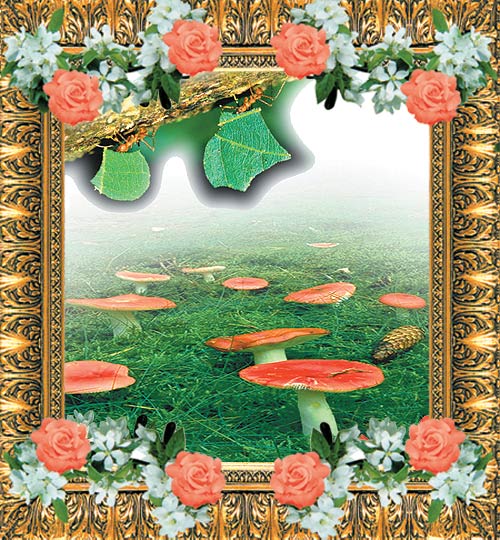
The micro-organisms, tiny insects, bacteria, fungi, leafcutter and other species of ant that live on the rain forest floor are responsible for cleaning the forest and keeping it fertile.
These numbers do not represent the total number of living organisms in a particular habitat, just the number of species. Another astonishing fact is that in tropical rain forests, according to some experts, millions or even tens of millions of living things live in complete harmony and co-operation..
Soil in tropical rain forests is generally thought of as being rich and fertile. Recently, however, it has been realized that this is not so. In terms of nutrients, the soil is poor, compared to that of other forests.48 How did such a great variety of plants emerge from poor soil? The answer lies in the perfection of the rain forest ecosystem.
The biodiversity in tropical forests has been created as a whole, and is based on very delicate, complementary balances. For instance, consider the micro-organisms, minute insects and fungi living on the forest floor. Their dimensions are very small in comparison to the trees and animals, yet they are responsible for cleaning the forest and making the soil productive. They break down dead animals and leaves and branches that fall from the trees, recycling them back into the ecosystem. In this way, nothing is wasted. Professor Wilson describes the importance of this mechanism:
The leafcutters and other kinds of ants, together with bacteria, fungi, termites and mites, process most of the dead vegetation and return its nutrients to the plants to keep the great tropical forests alive. 49
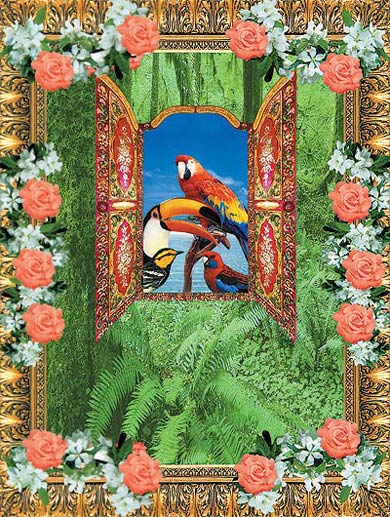
A rain forest's most characteristic feature is the astonishing variety of the life it contains one hectare (10,000 square meters or 11,960 square yards) of tropical rain forest may contain more than 600 different species of tress. In a single day; 440 species of butterflies can be collected in one region of the Amazon Basin. Forty- three separate species of ant and 650 different insect species can be found living on a single tree.
We still do not know how many millions of species live in tropical rain forests, but we do know that every species has a different task and importance in these ecosystems, and that these species live together in harmony. This is expressed in an article about Amazon rain forests in the Turkish magazine Bilim ve Teknik ("Science and Technique"):
The continuity of species in this Amazon Basin's complex ecosystem is based on their close dependence on one another. Every species, be it plant or animal, contributes to part of this system with its millions of components. Trees, the epiphytes on trees, fungi, monkeys, vampire bats, eagles, parrots, the crocodiles, piranha fish and lilies in the river, and micro-organisms invisible to the naked eye all make different contributions to the giant ecosystem in which they live. There are very delicate balances here. The rain forest exists together with all these species. The disappearance of a single species will damage several of these balances. 50
Indeed, such great harmony and interdependence exist among some species in the forest that one cannot survive in the absence of the other. Some 90% of the trees in the rain forest need animals to spread their seeds,51 while insect larvae, caterpillars, birds and other animals feed on the seeds of these trees. For example, species of fig tree and fig fly species are so interdependent that either cannot survive in isolation from the other. In the absence of fig flies, fig trees cannot fertilize themselves, and in the absence of fig trees, fig flies are deprived of their natural habitat. There is a different species of fig fly for every one of the more than 900 species of fig tree in tropical regions!52
Traits such as the fig fly's body and mouth structure and the flower's structure and reproductive organs, as well as the insect's flights and the times when the flowers open are in complete harmony. Accounting for this utter dependence between species has always been difficult for Darwinism. For this phenomenon, there is only one explanation: The harmony between plants and animals is a marvel of Creation. There is no chance of this system developing over time through small random changes and the mindless mechanisms of evolution.
Take, for example, the harmonious existence of the hawk moth Xanthopan morganii and one species of Madagascar orchid. To collect nectar, this moth extends its proboscis, some 30 to 35 centimeters (11 to 13 inches) in length, around 30 centimeters (11 inches) deep into the body of the orchid, and thus enables it to be fertilized.53 In order to reach and fertilize the ovary at this depth, the moth needs a proboscis of just such a length, In other words, the two species must be totally compatible with one another.
This represents a major dilemma for evolutionists, because it is impossible for these two different species to have undergone a parallel process of evolution, much less at the same time.
Let us assume that the ancestors of the Madagascar orchid and the Xanthopan morganii moth had had, respectively, much shorter nectary and a much shorter proboscis. (This is the assumption that must be made, according to the theory of evolution.) In that case, both species would have extended their parts simultaneously. The hawk moth and the orchid, would each have been exposed to mutations that simultaneously extended the length of their proboscis and nectary. Of course, such mutations would have had only advantageous effects on these two life forms (and beneficial mutations have never been observed). They would have to out-multiply other members of their species that had not undergone mutation, and this supposed process of natural selection would have to continue completely by chance, but without error, for millions of years.
Tropical rainforests are often calied "the lungs of the world" because during photosynthesis, their countless plants absorb carbon dioxide and release oxygen.
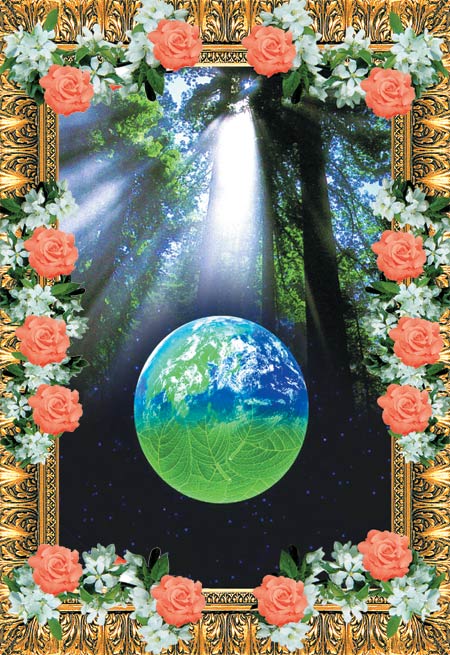
Say: "Have you thought about your partner deities, those you call upon besides God? Show me what they have created of the earth; or do they have partnership in the heavens?" Have We given them a book whose Clear Sings they follow? No indeed! The wrongdoers promise each other nothing but delusion. (Surah Fatir, 40)
To believe that is like believing that a lock and the key that opens it each came to be independently, but in a manner totally compatible with each other. Yet clearly, reason requires us to accept that two structures completely compatible with one another are both examples of simultaneous creation. To put it another way, reason requires us to accept that the orchid and the moth were created in harmony with each other.
Another example of the flawless harmony among tropical life forms can be seen in those regions known as flood forests, found along the shores of the Amazon and its tributaries. When the rain is heaviest, they are flooded, and during this period, a marvelous phenomenon takes place. Fish come to eat the fruits that fall into the water and distribute the seeds of those fruits of several species of tree.
Clearly, the variety of species in the rain forests are of great importance to the native peoples living there. But what importance can they have for the billions of humans who do not live in such regions? Scientists have provided the answer: The plants and animals in these tropical forests are of vital importance to every human on Earth. They are described as "the Earth's lungs" because of the way they absorb carbon dioxide from the atmosphere during photosynthesis and give off oxygen. Rain forests play a major role in the circulation of carbon and oxygen in the atmosphere, the global climate system, water circulation on Earth, and in many other natural balances. In addition, they represent a splendid source of new foods, products and medicines.
The magnificent variety of life in the rain forests is a major headache for Darwinism. The situation does not even permit evolutionists to offer any of their tall tales. Indeed, evolutionist researchers admit that they do not know the reason for the tropical rain forests' glorious biodiversity.54 Yet very evidently, God has created the single-celled organisms, plant and animal species in these forests, just as He has created all living things. If evolutionists wish to find a way out of the dead end they find themselves in, they must accept this fact.
To grasp just how irrational the evolutionist claim is, imagine a large factory that manufactures dozens of different products—a wide range of technological devices such as televisions and computers. Now, could these various products all have been invented by chance, with no conscious intervention? Could these devices, products of advanced technology, gradually form through the effects of such natural phenomena as the sunlight, wind, and lightning?
Such an event is of course impossible; both a factory and the devices it manufactures result from the design and planning by engineers and various other experts. Now consider the rain forests, home to tens of millions of different species, all with systems far more complex than those in any electronic devices available today. Such an environment, consisting of life forms that have lived together in harmony and co-operation for millions of years, could not come into being spontaneously, right down to the very finest detail, as evolutionists claim. The sublime intelligence here belongs to God, the Lord of the worlds..
Coral Reefs
Coral reefs come about gradually as dead corals, algae and crustaceans accumulate in different layers. They are found in tropical seas and can spread over rather large areas. In addition to their wealth of color and form, coral reefs harbor a variety of life, comparable to that in the rain forests. Many marine creatures, from planktons too small to be seen with the naked eye to sharks up to 6 meters (19 feet) long inhabit coral reefs.
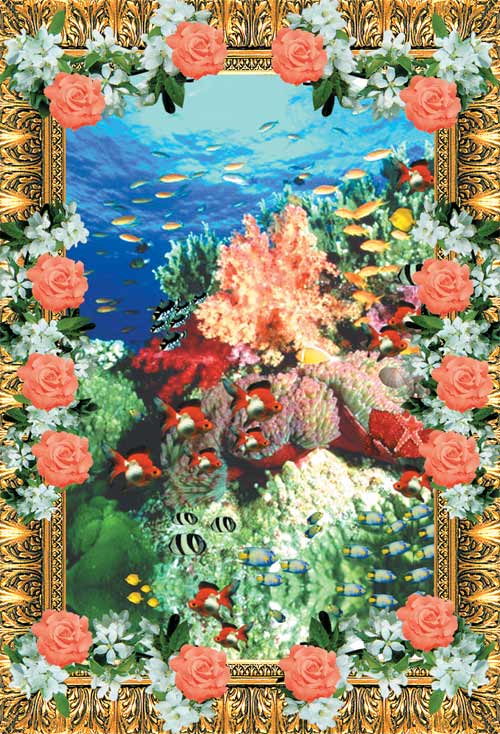
According to Marjorie Reaka Kudla, Professor of Zoology at Marylan University the number of described species in the world's coral reefs is 93,000, and the estimaded number should be about 950,000. It is Almighty God Who creates every one of these life forms together with perfect systems.
Tens of thousands of widely different species live on coral reefs: Spotted, striped, brightly colored fish with striking patterns, fish that live in colonies, bright-hued corals, crustaceans with different appearances, eye-catching sea plants, sponges unique to coral reefs, mussels, oysters, sea urchins, crabs, starfish, micro-organisms, invertebrates...
At 2,000 kilometers (1,243 miles) long, Australia's Great Barrier Reef is the world's largest structure composed of living organisms. It plays host to 2,000 different species of fish, 350 species of coral, and 4,000 species of mollusks.55 But these are only the numbers of species identified to date. New species of animal and single-celled organisms are discovered every year.
According to Marjorie Reaka-Kudla, Professor of Zoology at Maryland University, the calculated number of described species on coral reefs is 93,000, and the estimated number should be about 600,000- 950,000 species.56
In the same way as rain forests, coral reefs are full of living things created in such a way as to complement one another and meet each other's needs. For example, coral polyps live shared or symbiotic lives with single-celled algae (zooxanthellae) inside their tissues and green algae on their outer surfaces. Coral polyps take some of the nutrients produced by algae through photosynthesis. Algae, on the other hand, obtain the nutrients they need from the coral polyps. At the same time, the polyps provide a safe place for the algae to live.
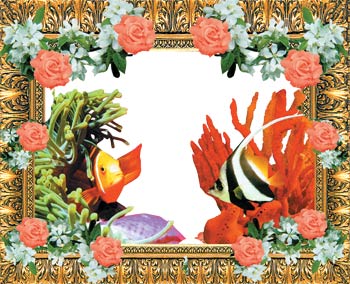
Coral reefs are generally found in waters classified as being poor in terms of nutrients.57 The question of how the reefs managed to grow in such waters has long been of great interest.58 According to the latest research, one reason for the wealth of species on the reefs is that these animals work together in harmony and co-operation. One study published in the 18 October, 2001 edition of Nature magazine, revealed the importance of the species of sponges, mussels and ringworms living in the cavities in the reefs. By filtering vegetable plankton, these organisms, most of which are very small, secrete substances such as ammonia and phosphate, needed by coral animals.59 In short, the system—consisting of thousands of small living species living in cavities in the reefs—serves like an enormous filtering station.
We obtain some real benefits from the micro-organisms, plants and animals in the ecosystem: Corals secrete the calcium they absorb from the sea in the form of calcium carbonate. Working like a sophisticated chemical laboratory, they play an important role in regulating carbon dioxide balances, in both the ocean and the atmosphere. The fish, mussels and other living organisms in the coral reefs represent food sources for hundreds of millions of people. Since coral reefs generally form close to the surface, they protect shorelines from the damaging effects of large waves, thus preventing erosion and reducing the harm done by storms. Thanks to coral reefs, the water between the shore and the reef is more tranquil in comparison to the open sea, constituting a habitat more suitable for fish and crustaceans.
In addition, the wealth of genetic material from the wide variety of life on coral reefs is used in medical research and in the development of new drugs. Douglas Chadwick, a biologist and writer for National Geographic magazine, expresses some of these benefits we enjoy from the coral reefs:
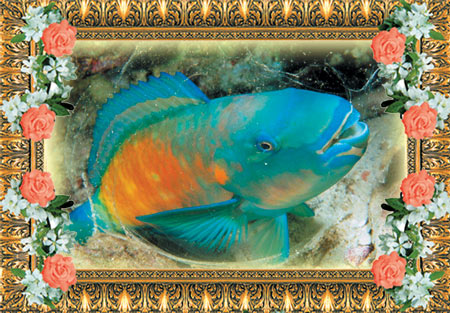
Parrot fish camouflage themselves at night by encasing their entire bodies with a gelatinous substance.
Humanity's ties to the creatures living around coral reefs may multiply as medical research taps more of the organisms at home there. Some have already yielded compounds active against inflammations, asthma, heart disease, leukemia, tumors, bacterial and fungal infections, and viruses, including HIV. Studies found that chemicals used by sea slugs and certain sponges to repel fish also work on land as insecticides. Screening the venom of tropical cone snails for pharmaceutical properties turned up a possible nonaddictive substitute for morphine. Sea whips, related to true corals, offer a potential painkillers as well, while coral skeletons themselves are being investigated as substrate for bone grafts. 60
Each of the species living on coral reefs has been equipped with extraordinary systems and characteristics. For instance, some fish and other creatures have more color receptors than human beings, and therefore perceive colors better than we do.61 Most coral reef fish are able to change their colors to a certain extent, and some species can do so as quickly as a chameleon.62 The large-eyed sea bass and squirrel fish are able to hunt at night, or at depths where no daylight penetrates, thanks to their sensitive eyes. Puffer fish defend themselves by inflating their stomachs like a balloon and erecting their spines.63 Parrot fish camouflage themselves at night by covering themselves with a gelatinous sheath; they feed on algae by breaking off pieces of coral with their powerful, beak-like mouths.64 Scavenger fish and cleaner shrimp live off parasites on the fishes' skin. These, of course, are only a few of the perfect systems and flawless cooperations found among life forms on the reef.
Some reef-living fish species are able to camouflage themselves very well, thanks to their colors that closely match those of their surroundings. Species such as angel fish and butterfly fish possess very striking colors. Since they can easily be detected by predators, one would expect them to soon become extinct. But these fish survive despite their striking colors thanks to their own particular methods of defense. Evolutionists are unable to account for this state of affairs, which is the exact opposite of Darwinist expectations.
One evolutionist researcher studying this is the marine biologist Justin Marshall of Queensland University. In an article, "Why Are Reef Fish So Colorful?" in Scientific American magazine, Dr. Marshall describes this mystery "as tantalizing as it is beautiful." 65
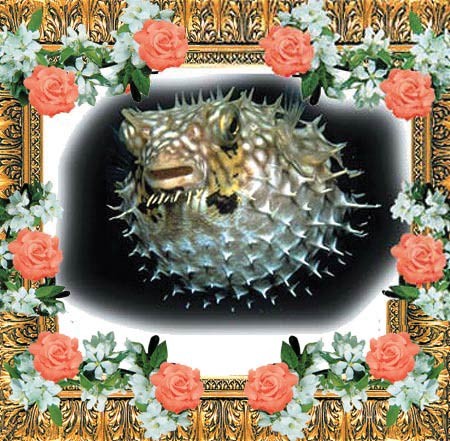
Porcupine fish protect themselves by distending their stomachs like balloons and erecting the spines on their skin
In fact, there is no mystery here at all, nor anything disappointing, only history being repeated. Darwin himself described as "trifling particulars of structure [that] often make me very uncomfortable. The sight of a feather in a peacock's tail, whenever I gaze at it, makes me sick!"66 These same difficulties are also faced by his followers. In short, the variety of life on the reefs, animals with incomparable features and the prefect harmony among species represents a nightmare for Darwinists. To wake up from that nightmare, they need to admit that God created the reef fish with their stunning colors and appearances.
People who keep marine aquariums as a hobby know how very difficult it is to feed tropical reef fish and corals. The main reason is the need to constantly replicate these creatures' reef habitats. In a marine aquarium, the salinity, temperature, pH level, light, oxygen level and chemical combinations in the water need to be kept in balance. Such corals and fish in are prone to be affected by even small changes in their aquarium environments. The organisms will die unless the ideal conditions are maintained and constantly regulated by technological equipment.
Now, bearing in mind the difficulty of running a marine aquarium containing just a few species of coral and fish: Could the tens of thousands of species living on the coral reefs have come into being spontaneously, or by chance? Could their striking colors, impressive hunting and defense systems, unique body structures, sense organs, systems and genetic information be the work of coincidence? Could the reef environment—in which the plants, animals, plankton and micro-organisms have lived in harmony and order for millions of years—have come about without a superior and conscious intervention?
Of course these events are impossible. Anyone able to reason can see their illogicality. Reef creatures with their amazing characteristics demonstrate the sublimity and glory of their Creation; they reveal the infinite artistry and omniscience of God, their Creator.
Deep-Sea Creatures
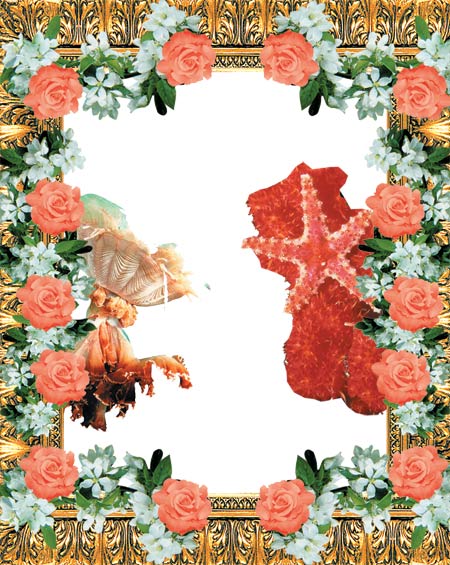
Research has demonstrated the astonishingly rich species diversity that exists several thousands of meters down in the oceans, where it was once believed that there was no life at all.
While walking along the seashore, you must have noticed seaweed and various sea plants.. These and some microscopic planktons produce their own nourishment by way of photosynthesis. This represents the first step in the marine food chain. However, sunlight cannot penetrate deeper than 100 meters (328 feet) in sea water, and the deepest ocean depth is 11,000 meters (36,090 feet) beneath the surface, with an average depth of 5,000 meters (16,400 feet). There is no possibility of photosynthesis taking place there, under conditions of high pressure per square inch, a low temperature in the region of 2 to -4 degrees Celsius (35 to 39 degrees Fahrenheit), and constant darkness. The only food sources consist of waste products and organic substances raining down from higher up. In short, the environment is completely different from what humans are familiar with. Despite all these inhospitable conditions, however, various fish and very different invertebrate creatures and micro-organisms still thrive in the ocean depths.
Temperature, pressure, the density of foodstuffs and light levels vary according to the further down from the surface one descends. Yet living things with structures and systems suited to their environment are found at all depths. Down there are fish, mussels, sea lilies, sponges, crustaceans, shrimps, crabs, arthropods, octopuses, ink fish, worms with spiny bodies, starfish, sea urchins, jellyfish, lobsters, single-celled organisms and organisms whose names can be encountered only in advanced biology texts and can be seen only in nature documentaries, all of them unique to the ocean depths.
Frederick Grassle and Nancy Maciolek, well-known American marine ecologists, say there may be 10 million species beneath the sea,67 and an astonishing wealth of species several thousand meters beneath the surface, in an environment previously believed to contain no life at all. Based on his research, Grassle, Director of the Rutgers University Marine and Coastal Research Institute, makes the following comment:
This sampling revealed that the deep-sea may, in fact, rival tropical rainforests in terms of the numbers of species present. Thus the deep sea may physically resemble a desert, but in terms of species composition, it is more like a tropical rainforest. 68
In one study 1,500-2,500-m depth range off New Jersey and Delaware, 30 cm x 30 cm samples of sea water contained 798 species in 171 families and 14 phyla.69 In another study performed off the coast of southern Australia, more than 800 species were determined in 10 square meters (11.96 square yards) of the sea floor.70
Yet a large part of the oceans have still not been the subject of scientific research. Much of the bottom of the world's oceans are still unexplored and unmapped.71 Therefore, every new investigation reveals some previously unknown species.
One biological phenomenon discovered at the beginning of the 21st century was that in the ocean floor's mud layer, certain bacteria and archaeobacteria consume methane, and thus perform an activity of vital importance to our lives. It is thought that these micro-organisms consume devour 300 million tons of methane every year, about as much as humans now inject into the atmosphere with agriculture, landfills, and burning of fossil fuels.72 Therefore, as stated in Science magazine of July 20, 2001, "These methane-eating microbes—once thought to be impossible—now look to be profoundly important to the planet's carbon cycle."73
Another striking fact is the flawless co-operation and order among the bacteria in question, revealed only with this century's technology: Thanks to archaeobacteria (which have a number of different structural features) bacteria can feed on methane in an oxygen-free environment, because the archaeobacteria in turn provide the oxygen that the bacteria need.
These creatures, too small to be seen with the naked eye, live thousands of meters down in the oceans in a layer of mud containing no oxygen, where they work non-stop. What would happen if these single-celled organisms disappeared? Their importance is crystal clear: Should these micro-organisms vanish, then large quantities of methane gas ion in the sea bed would enter the atmosphere. Global warning of mud due to the greenhouse effect would occur. The climatic balance would be damaged all over the world, and the Earth would become a planet too hot for us to live on.
In 2001, it was learned that certain species of bacteria live beneath the ocean bed, in the Earth's crust.74 These organisms' natural habitat lies up to 300 meters (985 feet) beneath the ocean floor, and thousands of meters under the surface. The activities they carry out are equally astonishing. These bacteria feed on rocks, and in doing so, perform another task of the greatest importance to all living things, making a major contribution to the flow of elements and chemical substances in the oceans.75 Note that these single-celled organisms do something, so important to life on Earth, that even the entire world's laboratories and scientists could not manage were they to join forces.
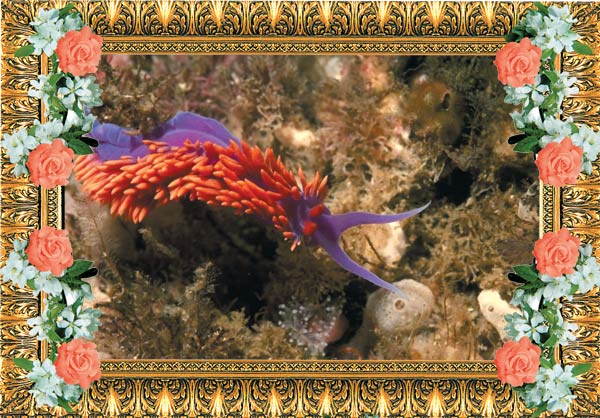
Despite such adverse conditions as high pressure, low temperatures and scarce food resources, various animals, different-colored crustacean and micro-organisms thrive in the dark ocean depths.
Another ecosystem on the ocean floor is found around hydrothermal vents,76 where superheated water containing various minerals emerges from cracks in the Earth's crust. More than 300 unique species have so far been discovered living in close proximity around these springs, which were discovered only in the past 20 years.77 This environment is home to large tube worms several meters in length and covered in bright red hairs, giant oysters, mussels, squid and invertebrates with all kinds of different appearances. Understandably, it has attracted great interest from researchers. In the search to answer how these creatures find food, astonishing facts have emerged.
The tube worm found in the ecosystem around these hydrothermal vents is very different from the other worms we are familiar with: It has no mouth or digestive system! It meets its nutritional needs thanks to the bacteria that live inside its tissues—a total of 285 billion bacteria per ounce of tissue.78 These bacteria perform chemosynthesis, transforming chemical substances that emerge from the springs into nutrients, which the worms use to live.
The bacteria at the bottom of the ocean are the first link in the food chain. Thanks to these micro-organisms, some invertebrates able to survive, and some animals, such as the squid, survive thanks to these invertebrates. The wealth of species and harmony among them, in an environment that until recently was thought to contain no life at all, is truly amazing.
Also, it was recently established that various species are living near the water leaks on the ocean floor, which are chemically rich but cold. Each new study and development indicates how little we know about the richness of the ocean bed.
Bear in mind that submarines used in deep-sea exploration were developed only in the last 70 years. The exploring submarines that dive down thousands of meters have been specially designed by experts from various fields. Similarly, each species that has lived for millions of years at the bottoms of the deepest oceans has also been created with a structure appropriate to its hostile environment. Moreover, the mechanisms in these creatures' cells are many times more complex than the systems in research submarines. Structures so complex cannot, as evolution claims, have come into being by chance. The variety of living things in the depths of the oceans, and their superior characteristics, belong to God, the Creator of all things.
Bacterial Ecology
When life is mentioned, plant and animal species generally come to mind. Some people even imagine that life consists solely of these. However, another living group which—despite being too small to be seen with the naked eye—constitutes 25% to 50% of all living species on the Earth: micro-organisms.79
Bacteria represent the most important portion of these micro-organisms. These may be spherical, rod-like or spiral in shape. Most are smaller than 0.001 millimeters (0.00003937 inch) in size, so small that hundreds of thousands could fit into the period at the end of this sentence.80
Every ecosystem and all living species depend, either directly or indirectly, on the activities of bacteria. (Their essential importance to the delicate balances of life on Earth will be described in later sections.) They can be found just about everywhere.81 Thousands of species of bacteria exist in ice caps, hydrothermal vents, environments with high levels of salinity or acid, amid chemical contaminants or pollutants, in the organs and tissues of animals and human beings, in the depths of the seas where there is little or no oxygen, and in the deep layers of the Earth.
For example, the intestines of a healthy human being are an ecosystem containing 400 different species of bacteria, organisms that play a very important role in the regular functioning of the intestines.82
Bacteria are part of a group that exhibits the greatest diversity among living things. but about which the least is known.83 Their diversity is far beyond the grasp of even 21st century technology. You could say that a gram of soil containing thousands of species of bacteria and billions of individuals resemble a rain forest at the microscopic level. In other words, an extraordinary diversity similar to a rain forest's can also be found in a handful of earth under the microscope.
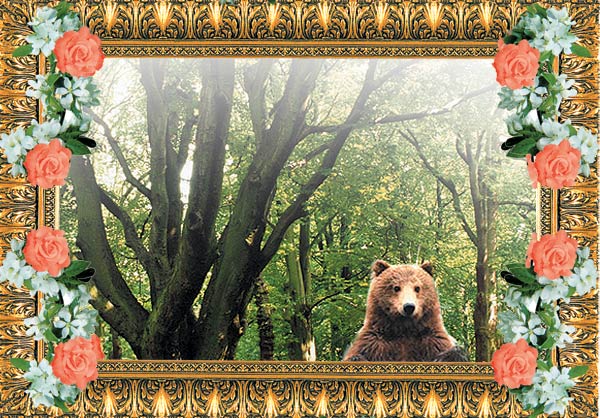
When the genetic structures of bacteria—which look identical to one another even under the microscope—were examined, it was realized that these actually constituted very different species. As the Northwestern University microbiologist David Stahl expressed it, these bacteria can be as different from one another as a brown bear is from an oak tree.
To date, scientific studies aimed at determining bacteria and microbe species are very much fewer than actually needed. It is difficult to investigate these organisms for a number of reasons: Most species of bacteria cannot be raised in the laboratory or in cultures, even though a drop of sea water or tiny amount of soil contains billions of them. Even the unbelievable wealth of bacteria species has been realized only in recent years, with advances made in our knowledge of genetics.
When the genetic structures of microbes that appear very similar even under the microscope were examined, they were found to be actually very different species. In the words of the Northwestern University microbiologist David Stahl, two microbes can be "as different from each other as a grizzly bear from an oak tree."84
In his book In Search of Nature, Edward O. Wilson summarizes the latest developments regarding these micro-organisms:
The true black hole of systematics, however, may be bacteria. Although roughly 4,000 species have been formally described, recent studies in Norway have indicated the presence of from 4,000 to 5,000 species, almost all new to science, among the 10 billion individual organisms found on average in each gram of forest soil, and another 4,000 to 5,000 species, different from the first set and also mostly new, in an average gram of nearby marine sediments.85
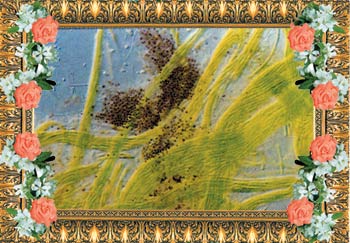
"Although bacteria are tiny, they display biochemical, structural and behavioral complexities that outstrip scientific description. In keeping with the current microelectronics revolution, it may make more sense to equate their size with sophistication rather than with simplicity... Without bacteria, life on earth could not exist in its present form." (James Shapiro)
Another expert on the subject, Rita Colwell, former President of the Maryland University Biotechnology Institute, gives the following figures regarding the wealth of bacteria on Earth:
Only 3,000-4,000 species of bacteria have been described. It has been estimated that there may be as many as 300,000 species of bacteria, but more likely the number is closer to 3,000,000.86
Most of us think of bacteria as entities that merely cause disease. Yet this is not correct. Only a small fraction of bacteria species are agents of disease.87 As Andrew Pollack described in an article, bacteria play an essential role in the formation and continuity of life on Earth and in maintaining balances essential to life.88 This fact is set out by Professor James Shapiro from the Chicago University Department of Biochemistry and Molecular Biology:
Although bacteria are tiny, they display biochemical, structural and behavioral complexities that outstrip scientific description. In keeping with the current microelectronics revolution, it may make more sense to equate their size with sophistication rather than with simplicity. . . . Without bacteria, life on earth could not exist in its present form.89
Although they multiply very rapidly and are so small and numerous, bacteria act in such ways as to permit not the slightest confusion. There is only one explanation: Every detail regarding bacteria, from the exceedingly complex activities they perform (such as the photosynthesis performed by cyanobacteria) to the numbers of their individuals and species, is as wished and determined by God, Who created them. God knows and plans where, when and in what numbers they need to be, and makes them a vehicle in the regulation of the balances on Earth and in forming environments suited to human life.
There is no one in the heavens and Earth who will not come to the All- Merciful as a slave. He has counted them and numbered them precisely. (Surah Maryam, 93-94)
Footnotes
2 David Tilman, "Causes, consequences and ethics of biodiversity," Nature, vol. 405, 11 May 2000, pp. 208-211.
3 Marjorie L. Reaka-Kudla, Don E. Wilson, Edward O. Wilson (editors), Biodiversity II: Understanding and Protecting Our Biological Resources, E.O. Wilson, "Introduction," p. 1, Washington D.C.: Joseph Henry Press, 1997.
4 Encyclopedia Britannica 2001 Deluxe Edition CD, "The importance of the biosphere."
5 Edward O. Wilson, In Search of Nature, Washington D.C. Island Press/ Shearwater Books, pp. 153-171.
6 Marjorie L. Reaka-Kudla, Don E. Wilson, Edward O. Wilson (editors), Op cit.; Thomas E. Lovejoy, Biodiversity: What Is It?, Washington D.C.: Joseph Henry Press, 1996, p. 7.
7 Marjorie L. Reaka-Kudla, Don E. Wilson, Edward O. Wilson (editors), Op cit.; Q.D. Wheeler, J. Cracraft, Taxonomic Preparedness: Are We Ready to Meet the Biodiversity Challenge, Washington D.C.: Joseph Henry Press, 1996, p. 436.
8 Taylor H. Ricketts, "Conservation Biology and Biodiversity", Encyclopedia of Life Sciences, 2001, ğ.els.net.
9 Alessandro Minelli, "Diversity of Life", Encyclopedia of Life Sciences, 2001, ğ.els.net.
10 M. Encarta Encyclopedia 2001 Deluxe Edition CD, "Biodiversity."
11 Encyclopedia Britannica 2001 Deluxe Edition CD, "Evolution".
12 E.O. Wilson, "The Current State of Biological Diversity" in E.O. Wilson, F.M. Peter (editors), Biodiversity, Washington D.C.: National Academy Press, 1988, p. 14.
13 E.O. Wilson, "Introduction," in Marjorie L. Reaka-Kudla, Don E. Wilson, Edward O. Wilson (editors), Biodiversity II, Washington D.C.: Joseph Henry Press, 1997, p. 2.
14 Andy Purvis, Andy Hector, "Getting the measure of biodiversity," Nature, Vol. 405, 11 May 2000, pp. 213-214.
15 Taylor H. Ricketts, "Conservation Biology and Biodiversity", Encyclopedia of Life Sciences, 2001, ğ.els.net.
16 Alessandro Minelli, "Diversity of Life", Encyclopedia of Life Sciences, 2000, ğ.els.net.
17 N. Myers, R.A. Mittermeier, C.G. Mittermeier, G.A.B. Da Fonseca, J. Kent, "Biodiversity hotspots for conservation priorities," Nature, vol. 403, 24 February 2000, p. 853.
18 "Biodiversity", http://encarta.msn.com/encyclopedia_761579557/Biodiversity.html
19 Species 2000, Indexing the World's Known Species, http://www.sp2000.org.
20 Andrew Lawler, "Up for the Count?," Science, Vol. 294, 26 October 2001, p. 769; http://www.catalogueoflife.org/dynamic-checklist/info_about_sp2000.php
21 "What is IBOY?", http://www.nrel.colostate.edu/projects/iboy/index2.html#whatbiodiv.
22 "Scientists Launch The International Biodiversity Observation Year (IBOY) To Raise Awareness Of Biodiversity", Science Daily Magazine, 2001, http://www.sciencedaily.com/releases/2001/01/010103072716.htm
23 All Species Foundation, http://www.all-species.org/
24 Andrew Lawler, "Up for the Count?", Science, Vol. 294, 26 October 2001, p. 769.
25 E.O. Wilson, "Introduction", p. 2, Marjorie L. Reaka-Kudla, Don E. Wilson, Edward O. Wilson (editors), Biodiversity II, Joseph Henry Press, Washington D.C., 1997.
26 Peter H. Raven, "Our Diminishing Tropical Forests," p. 120, E.O. Wilson, F.M. Peter (editors), Biodiversity, Washington D.C.: National Academy Press, 1988.
27 Alessandro Minelli, "Diversity of Life", Encyclopedia of Life Sciences, 2000, ğ.els.net
28 Skeletons In The Closet: One Fifth of Species Names May Be Invalid", Science Daily Magazine, 14/11/2001, http://wwwsciencedaily.com/releases/2001/11/011114071056.htm.
29 How Many Species Are There?", World Resources Institute, 2001, http://biodiv.wri.org/pubs_content_text.cfm?ContentID=535
30 Norman Myers, "The Rich Diversity of Biodiversity Issues," in Marjorie L. Reaka-Kudla, Don E. Wilson, Edward O. Wilson (editors), Biodiversity II, Washington D.C. Joseph Henry Press, 1997, p. 125.
31 Nigel E. Stork, "Measuring Global Biodiversity and Its Decline," in Marjorie L. Reaka-Kudla, Don E. Wilson, Edward O. Wilson (editors), Biodiversity II, Washington D.C.,: Joseph Henry Press 1997, pp. 41, 61.
32 Ayşe Turak, "Doğaya Sıcak Bakmak," Bilim ve Teknik ("Science and Technique"), December 2000, p. 63
33 National Geographic, http://news.nationalgeographic.com/news/2000/12/1201_russianlake.html, December 1, 2000.
34 http://library.thinkquest.org/25014/what/decline.impact.html
35 Edward O. Wilson, In Search of Nature, pp. 197-198.
36 John Whitfield, "All Creatures Great and Small," Nature, Vol. 413, 27 September 2001, p. 344.
37 "Biosphere 2 Center," Columbia University, 2002, http://www.bio2.edu/
38 Joel E. Cohen, David Tilman, "Biosphere 2 and Biodiversity—The Lessons So Far", Science, Vol. 274, No. 5290, 15 November 1996, p. 1150-1151.
39 G.C. Daily, S. Alexander, P.R. Ehrlich, L. Goulder, J. Lubchenco, P.A. Matson, H.A. Mooney, S. Postel, S.H. Schneider, D. Tilman, and G.M. Woodwell, "Ecosystem Services: Benefits Supplied to Human Societies by Natural Ecosystems," 2002, http://www.esa.org/science/Issues/TextIssues/issue2.php.
40 Joel E. Cohen, David Tilman, Op.cit., p. 1151.
41 Thomas E. Lovejoy, "Biodiversity: What Is It?," in Marjorie L. Reaka-Kudla, Don E. Wilson, Edward O. Wilson (editors), Biodiversity II, Joseph Henry Press, Washington D.C., 1997, p. 8,
42 M. Encarta Encyclopedia 2001 Deluxe Edition CD, "Rain Forest."
43 Ibid., "Amazonian Biodiversity."
44 E.O. Wilson, "The Current State of Biological Diversity," in E.O. Wilson, F.M. Peter (editors), Biodiversity, Washington D.C.: National Academy Press, 1988, p. 9,.
45 Çağlar Sunay, "Yitirilmekte Olan Cennet Amazon" (The Amazon), Bilim ve Teknik , April 1999, p. 75.
46 "Terrestrial Arthropod Biodiversity : Planning a Study and Recommended Sampling Techniques," a Brief Prepared by the Biological Survey of Canada, (Terrestrial Arthropods) 1994., http://www.biology.ualberta.ca/bsc/briefs/brterrestrial.htm
47 Terry L. Erwin, "Biodiversity at its Utmost: Tropical Forest Beetles," in , Marjorie L. Reaka-Kudla, Don E. Wilson, Edward O. Wilson (editors), Biodiversity II, Washington D.C.: Joseph Henry Press, 1997, p. 27.
48 Encyclopedia Britannica 2001 Deluxe Edition CD, "Environment, Tropical Forest".
49 Edward O. Wilson, In Search of Nature, p. 143
50 Çağlar Sunay, Op cit., p. 75.
51 M. Encarta Encyclopedia 2001 Deluxe Edition CD, "Rain Forest."
52 D.H. Janzen, "How to be a Fig," Annual Review. Ecology Systemat., Vol. 10, 1979, p. 13.
53 M. Encarta Encyclopedia 2001 Deluxe Edition CD, "Butterflies and Moths."
54 Virginia Morell, "On the Origin of (Amazonian) Species," Discover, April 1997.
55 Douglas H. Chadwick, "Kingdom of Coral," National Geographic, 2002, http://www.nationalgeographic.com/ngm/0101/feature2/index.html
56 M.L. Reaka-Kudla, "The Global Biodiversity of Coral Reefs: A Comparison With Rain Forests," in Marjorie L. Reaka-Kudla, Don E. Wilson, Edward O. Wilson (editors), pp. 94, 102,.
57 Sarah Graham, "Scientists Explain How Corals Thrive in Nutrient-Poor Waters," Scientific American, 18 October 2001, http://www.sciam.com/article.cfm?articleID=000A8B4C-F12F-1C63-B882809EC588ED9F
58 C. Darwin, The Structure and Distribution of Coral Reefs, London: Smith, Elder & Company, 1842.
59 C. Richter, M. Wunsch, M. Rasheed, I. Kötter, M.I. Badran, "Endoscopic exploration of Red Sea coral reefs reveals dense populations of cavity-dwelling sponges," Nature, Vol. 413, 18 October 2001, pp. 726-730.
60 Douglas H. Chadwick, "Coral in Peril," National Geographic, January 1999, pp. 30-37.
61 Justin Marshall, "Why are Reef Fish So Colorful?," Scientific American: The Oceans, August 1998.
62 Ibid.
63 Ayşegül Yılmaz Günenç, "Mercan Kayalıklarında," Bilim ve Teknik, October 1999, p. 82.
64 Ibid.
65 Justin Marshall, Op cit., Scientific American, August 1998.
66 Carl Zimmer, Evolution: The Triumph of an Idea. New York: HarperCollins. p. 235.
67 J.F. Grassle, N.J. Maciolek, "Deep-Sea Species Richness: Regional and Local Diversity Estimates From Quantitative Bottom Samples", American Naturalist, vol. 139, 1992, p. 313-341.
68 Marcia Collie, Julie Russo, "Deep-Sea
Biodiversity and the Impacts of Ocean Dumping", 2000, http://www.research.noaa.gov/spotlite/archive/spot_oceandumping.html
69 .F. Grassle, N.J. Maciolek, "Deep-Sea Species Richness: Regional and Local Diversity Estimates from Quantitative Bottom Samples," American Naturalist, Vol. 139, No. 2, February 1992, pp. 313-341.
70 G.C.B. Poore, G.D.F. Wilson, "Marine Species Richness," Nature, Vol. 361, 1993, p. 579.
71 "Ocean", http://en.wikipedia.org/wiki/Ocean
72 Raşit Gürdilek, "Dünyayı Kurtaran Mikroplar" Bilim ve Teknik, September 2001, p. 10.
73 Carl Zimmer, "Inconceivable Bugs Eat Methane on the Ocean Floor," Science, Vol. 293, 20 July 2001, pp. 418-419.
74 David Whitehouse, "The Microbes That Rule the World," BBC News Online, 28 September 2001, http://news.bbc.co.uk/hi/english/sci/tech/newsid_1569000/1569264.stm
75 "Researchers Find Glass-Eating Microbes at the Rock Bottom of the Food Chain," Scripps Institution of Oceanography, 2001, http://www.spaceref.com/news/viewpr.html?pid=6137
76 Francesco Canganella, "Hydrothermal Vent Communities," Encyclopedia of Life Sciences, 2000, ğ.els.net.
77 "Sea Connections", Smithsonian Center for Education and Museum Studies, 2001, http://www.smithsonianeducation.org/educators/lesson_plans/ocean/connect/essay.html
78 Ibid.
79 Richard O. Roblin, "Resources for Biodiversity in Living Collections and the Challenges of Assessing Microbial Biodiversity," in Biodiversity II p. 467.
80 M. Encarta Encyclopedia, 2001 Deluxe Edition CD, "Bacteria."
81 Bacteria and Their Effects on Ground-Water Quality, http://mi.water.usgs.gov/h2oqual/GWBactHOWeb.html
82 The Intestinal System, http://www.webnat.com/educ/clIntestinalSystem.asp
83 Robert F. Service, "Microbiologists Explore Life's Rich, Hidden Kingdoms," Science, Vol. 275, Number 5307, 21 March 1997, pp. 1740-1750.
84 Ibid.
85 Edward O. Wilson, In Search of Nature, p.171.
86 R.R. Colwell, "Microbial Biodiversity and Biotechnology,", Biodiversity II, p. 282.
87 M. Encarta Encyclopedia, 2001 Deluxe Edition CD, "Bacteria."
88 Andrew Pollack, "A New Kind of Genomics, With an Eye on Ecosystems," The New York Times, October 21, 2003.
89 James A. Shapiro, "Bacteria as Multicellular Organisms," Scientific American, June 1988, p. 82.
